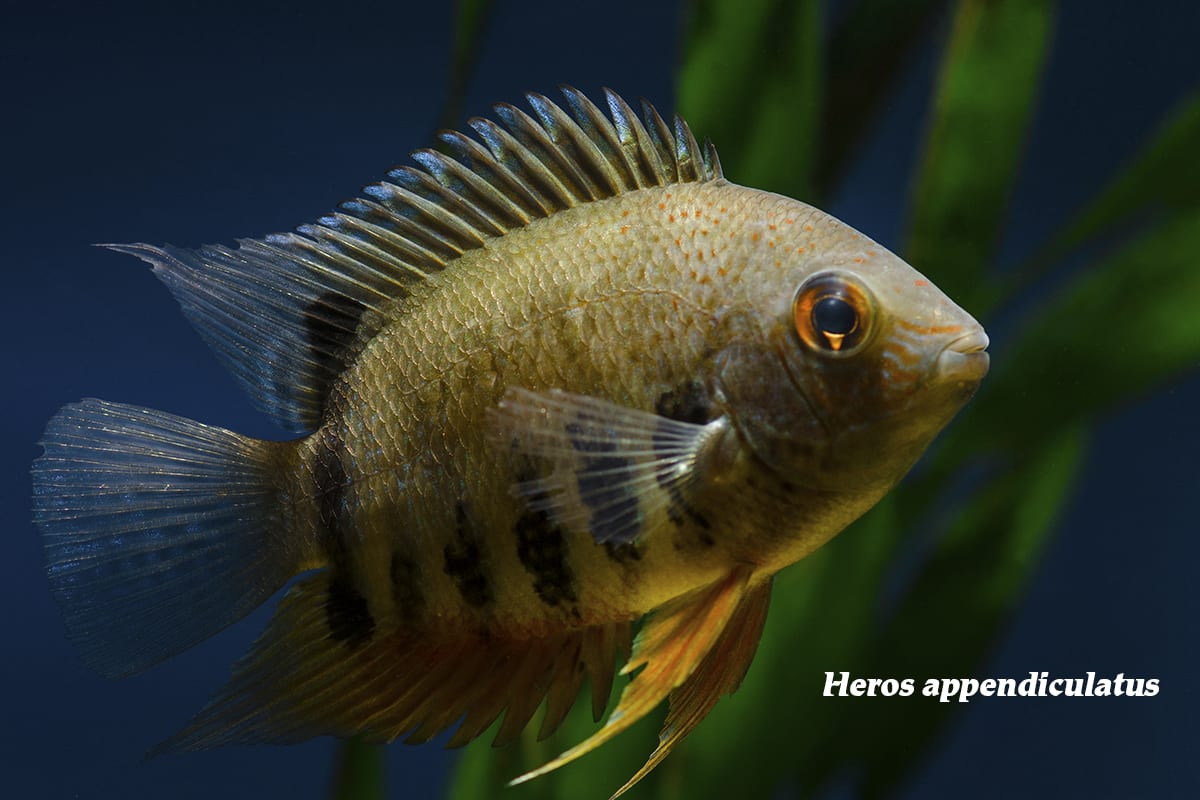Holi Water
Holi Water
Sunshine, blossoms, light jackets, and outdoor games are tantalizingly close as spring rounds the corner. For the Indian subcontinent, the arrival of March marks the beginning of spring, and is celebrated by the Hindu festival of Holi, or the “festival of colours”. A time to laugh and play with loved ones, and mend broken relationships, this festival relates the coming of spring and the end of winter with victory of good over evil. Humans have a long history of associating certain animals with concepts like good and evil, and figures like angels and demons, and fish are no different. This week, we celebrate Holi with fish that have signify these ideals: Pterophyllum leopoldi, Satanoperca daemon, and Heros appendiculatus.
Scientific NamePterophyllum leopoldi
Common NameLing-nosed Angelfish
Temperature / pH77 to 82°F / 5.0 to 6.0 pH
Native LocationAmazon basin
Preferred DietOmnivorous
Angelically floating through the drainage basin of the Amazon River is P. leopoldi. Also known as “Long-nosed Angelfish”, these elegant swimmers reach about 2 inches in length, exhibit the characteristic angelfish diamond body shape, with long ventral fins, and an exaggerated, pointed nose. They exhibit beautiful silver-gold coloration with dark vertical striping and a dark spot at the base of the dorsal fin. Widespread through the Amazon River system, they do best in deep, well planted tanks including tall plants like Amazon swords, open swimming space, and gentle water flow. More aggressive than many angelfish, they hold their own in well researched community tanks. Territorial when mating, they may nip at small fish, though their small mouths make them less threatening to anything larger than a small tetra. Additionally, long-nosed angelfish may squabble amongst their own kind to develop a pecking order. Thus, keeping them in small groups is recommended. Omnivorous by nature, they most likely feed on fruits, ants, termites, and other morsels found in the detritus layer on the substrate. In captivity they happily eat high-quality flake, and live or frozen foods like bloodworm or mosquito larvae. Opportunistic by nature, they will eat just about anything offered, and aquarists must take care not to overfeed.
Scientific NameSatanoperca daemon
Common NameThree Spot Eartheater
Temperature / pH75 to 82°F / 3.5 to 6.0 pH
Native LocationRio Negro
Preferred DietOmnivorous
More stern and domineering, S. daemon, keeps watch over the sandy bottoms of the Rio Negro watershed in the western Amazon basin. Name derived from ancient greek, “Satanoperca” translates to “Satan’s perch”, and “daemon” for “dispenser, god, protective spirit”. Reaching up to 9 inches in length, these eartheaters are dotted with lines of shimmering green scales, exhibit dark black spots along their sides and at the base of the caudal fin, and have bright red ventral, anal, and caudal fin accents. Most often found in blackwater habitats, tanks should be equipped with dim lighting, driftwood branches, scattered roots, and soft, sandy substrate is of utmost importance. Filter feeders that sift invertebrates and other food items like fruit out of the sand, allowing the inedible bits to escape through their gill slits. Any coarse substrate can do serious damage. In captivity they should be fed variable diets consisting of high-quality prepared foods, live and frozen bites, and gelatin-bound foods containing shellfish, fruit, and vegetables. To encourage natural browsing behavior, they should be fed 3-4 small meals a day rather than 1 larger offering. Generally peaceful when not breeding, these eartheaters do well in tanks with other, similarly-sized, peaceful species that will not compete for substrate meals. They will usually not predate on individuals of more than a few millimeters in size. Sensitive to water quality, external canister filtration or sump filtration is recommended, and treated water changes should occur frequently.
Scientific NameHeros appendiculatus
Common NameRed Spotted Severum
Temperature / pH74 to 84°F / 5.5 to 7.0 pH
Native LocationRio Ucayali
Preferred DietOmnivorous
Saving the day in the Rio Ucayali, H. appendiculatus is a rare beauty in the aquarium trade. Scientific name roughly translating to “hero with small appendages”, this fish reaches about 10 inches, and exhibits a shiny green body with dark black striping extending halfway up their bodies vertically from red underbellies. Preferring slow moving tributaries and floodplain habitats, tanks are best set up with sandy substrate, driftwood branches, tangled roots, leaf litter, and dim lighting. Netted bags of aquarium-safe peat are great filters, and help give the tank a black water feel. Fairly peaceful for its size when not breeding, this cichlid can be kept in small conspecific groups alongside other nonaggressive South American species. Opportunistic omnivores who will eat just about anything, they should be fed varied diets made up of high-quality dried foods, meaty fare like bloodworm, chopped earthworms, or prawns, and some vegetal matter like blanched spinach, shelled peas, or spirulina-based foods.
|


